IMPRESSIONS FROM CHINA 3 - DENIS DEPREZ
by Michèle Vicat
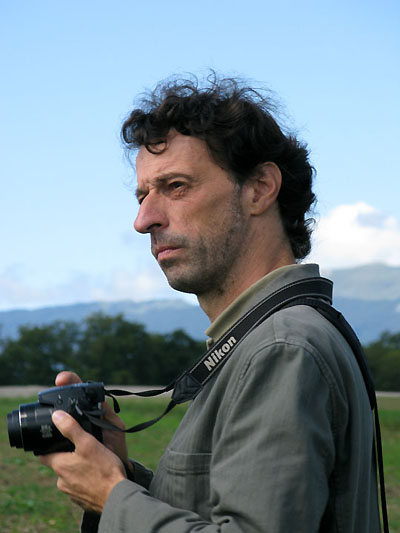
Denis Deprez, photographed by Michèle Vicat © 2011 |
For Denis Deprez, it was a trip to China, which radically transformed his interpretation of images. Not that he followed the teachings of a master of traditional Chinese landscapes or that he plunged into exotic fantasies. It was as an illustrator of comic books that the French magazine, XXI, asked him to recount his trip to Guangzhou in 2008. But, this Belgian artist had already begun to realize that drawing comic strips no longer suited him, and that he was transitioning to a graphic narrative because he was far, very far from his images of reference. A distance had inserted itself forever: a geographic distance, certainly, but also a distance with respect to the criteria that he had developed up until that point. From the new urban landscapes in China that he experimented with, Denis Deprez developed a new understanding of the relationship between nature and culture. From that time on, he walks, he walks a great deal in different parts of the world. Or rather, he traverses landscapes in their horizontalness and the acrylic traces left on the paper, the support for his mental voyage, set the scene through which the spectator can in turn explore freely when he wants.
Denis Deprez does not identify himself as a fine arts painter and he rejects any connection to contemporary art. He explores an unknown world, a Terra Incognita, a project which he calls “Fracture,” undoubtedly to tell us that our physical materialness can be found simultaneously in different places, that it is undeniably part of the world of appearances.
Let’s follow Denis Deprez in his home/studio in Brussels, Belgium.
What interested you in landscapes that are not completely industrial, but which carry the traces of industrialization?
Industry has been a presence in my life since childhood. The small town where I was born (Binche) was in the heart of a region whose economic and social history was bathed in coal and metallurgy. My father and my grandfather were workers in a metalworking factory. This presence of industry also came from by trips on the railway line between Binche and Brussels. There are many industrial sites along this line, so I have always had a relationship to an industrial countryside. It is practically inscribed in my neural system.
Recently, I was in Corsica, where I spent a week alone. I went hiking in the mountains every day, practically alone because it was not the season yet. I spent my days in nature that was very dense, very warm, on mule trails under an immense sky. I realized that something new had taken place. I had not been in the mountains since my adolescence. I found a connection, which I had lost, and which served as a counter point to industrial buildings. The hikes in the wilderness in Corsica let me integrate these landscapes. I needed to cross over them to experiment. I felt the rocks, the dust, the dead trees, the dried trees. There was no barrier between nature and me. It is this type of question, which interests me: a memory-image of nature will create a dialectic with respect to an industrial memory-image. A new type of collage or composition takes over.
 |
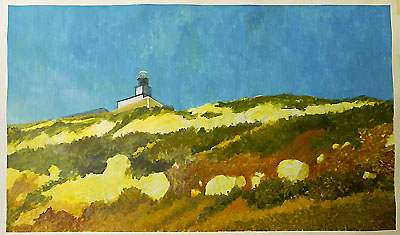
03-Fractures, acrylic on paper, June 2011, 180 x 120 cm
Click on this image and each image below to enlarge
|
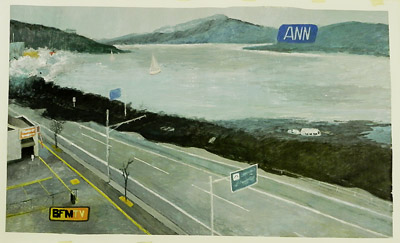 01-Fractures, acrylic on paper, April 2011, 180 x 120 cm 01-Fractures, acrylic on paper, April 2011, 180 x 120 cm
|
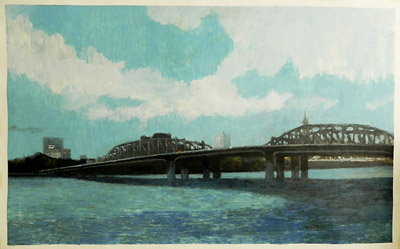
11-Fractures, acrylic on paper, April 2011, 180 x 120 cm
|
Here, we find ourselves in a room with three large format pictures. One represents a lighthouse on a hillside in Corsica. Another one represents the black wave at Fukushima, which swept way everything in its path, and the last represents a bridge in China. For me, it all begins a dialogue and launches a sort of narrative, whether one wants it or not. When you are in this room and you see these images, you begin construct something because all of these landscapes demand taking a position and adopting a narrative. That interests me very much. I am working in a timeframe that I call hetero-chronical because I am in a relationship to chaos and to the fracture in the process of narrative montage. The narrative process that is in place tries to establish a map of my visual memory that is sent back directly to the heart of the process, which is linked to my micro and macro geographic displacements. I can leave the place where I am producing images, experience a trajectory in my neighborhood or take a plane and travel to the other side of the world. This logic of displacement constitutes a new layer, which adds to the relationship between nature and culture. The accumulation of these images thus produces a stratification, which itself operates in several dimensions, as much in the accumulation as in the bursting apart, the flattening as well as the extending.
Here the images are very large format. How did you get to this format from comic strip images? Is it that the stories are different?
The sudden change took place with the publication in XXI*, where I suggested a new layout for the relationship between text and images. I began by photographing the landscapes and then transferring them to acrylic paper. This upheaval, this explosion of the usual comic strip format, happened when I was in China, in an environment in which I had lost all of my usual reading habits and where I had to reposition myself with respect to a new urban landscape.
(*XXI, Un Amour de Chine, Automne 2008-no.4)
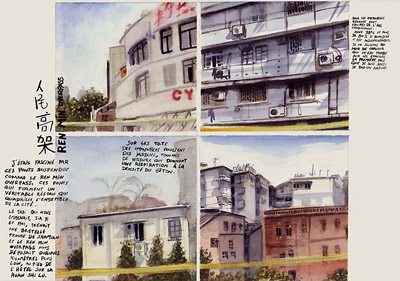 Plate published by XXI, 2008 © Denis Deprez Plate published by XXI, 2008 © Denis Deprez
|
What enabled you to change to an urban landscape?
I tried to show things in the most direct way possible in order to eliminate all the parasites. The transition from photography to painted images let me put in place a process for focusing. It is as if in photography there is still too, too much reality. In the transcription to acrylic, I traced the image through the flux of my memory. The image began to grow in my memory. It was a doubly articulated act of revelation because not only was the image revealed to myself, but it was also revealed to the reader. Each new image revealed to the reader/spectator constitutes a geographic and stratified narrative of my visual memory. Each image is practically a motif or fragment which places itself, and finally, I am a sort of revealing vector. I launch a process and from this process there are external accidents that feed the subject, but which also react because there are other motifs.
Another source of memory-images is my dream space. On this subject, I have a story to tell with respect to the Fukushima disaster. I often have a dream. I am on the Belgian coast. First, there is a blue sky. Everything is calm, but at a certain moment, there is a large wave, a tempest and then an enormous wave sweeps everything in its path. It is a dream, which I had several times until I was 35. But I “experienced” it so many times that I remember it as though I had dreamed it last night. Recently, I read W. J. Thomas Mitchell Iconology: Image,Text, Ideology (published by The University of Chicago) who helped launch Visual Studies in the United States. It is a school that dates from the 1970-80s in the US. In France, there is Jacques Rancière. Mitchell says that the dreamed image exists by itself, that it has its own existence. According to Mitchell, there is the “picture” that is the pure idea of the image. It is as if the image were floating, not fixed, and without any support. When this “picture” is fixed and becomes a photograph, for example, it becomes an “image”. Mitchell’s theory is powerful. For him, a dreamed image possesses its own material existence. It exists as an image in the matter of my dream subconscious. So I had this dream, which returned to my memory and I chose the dream image to inaugurate a large format cycle. I decided to fix this mental image and to transcribe it in acrylic. The wave is there. It streaks across the entire horizon and it seems to be approaching us. A week after I transcribed this image, the earthquake struck at Fukushima. This wave began the criticism of all of the images of landscapes produced before. There was the period of accident and catastrophe, which turned everything to chaos. So one has here a relationship between Story and History. For Jacques Rancière, the “Story” is the “little history” that is personal and “History” is the history of the rhythm of the world. So one has here a relationship between my own singularity revealed by the dreamed image of the wave (Story) and the image of the wave at Fukushima, which belongs to the collective memory (History). It is this that interests me: these images which come from outside and which impose a new reading of my own landscapes that are experienced or dreamed. There is here a whole series of images, which will act as critics of one and the other. And all of that will feed the narrative. Not only are you in the narrative of my travels, but also in the narrative of images, which act as critics of themselves. We are in the narrative of the process.
 28-Fractures, acrylic on paper, March 2011, 160 x 120 cm 28-Fractures, acrylic on paper, March 2011, 160 x 120 cm
|
The wave is clearly related to fluidity, but also possibly to the passage of thoughts. You are using new materials today as well as new formats. How do these new materials and formats move you in this new rapport with the narrative that you are undertaking?
For me, the material is the material of a narrative. I don’t present myself at all as a painter. I think that if I were to present myself as a painter, it would automatically destroy everything that I am trying to do. I am not a painter. I am someone who works with images and who uses images in a narrative with a specific montage. I think we are living at a special moment in the history of art in which there is contemporary art, which is bogged down and which has become orthodox. In contrast, all around this sphere, there are masses of people who come from graphic novels, illustration and other media: people who come from outside “fine art” but who arrive with new proposals and who rekindle interest in images. What is interesting for people like us is to propose a narrative dimension for images. We are living in the XXI century and it is necessary to see with what cultural and sociological configurations someone like me can propose a certain type of narrative, a narrative that invades the notion of space. There is consequently an upheaval in my approach. I am moving from space on the page to the space itself. I am in a new zone for investigating images. It is no longer a comic strip and it is not contemporary art. My proposal is outside the canons of esthetics and politics, which define the forms needed to participate in the special field of contemporary art.
That has allowed me to move to a different narrative space. The space on the page was no longer sufficient to put into play the narrative process instituted by large formats. I needed to move to a layout in space for these images. Space, in becoming narrative, can only be read by the presence of the spectator who, by perambulation, will in a certain way replay my journey across these landscapes.
When one is surrounded by several of your works, it is easy to realize the integration of the narrative to the image itself and to the dialogue, which is established between one work and another.
It is necessary to plunge the spectator into a sort of contemplation, which reveals a possible narrative to him or her.
I was recently invited to Corsica to give a conference. They asked me to illustrate my talk and I decided that that was not the right approach, and so I gave the entire lecture without showing any images. The people who came to see me after the lecture were full of images in their head! That means that the absence of images and the presence of my proposition were enough to recreate the rapport spoken-image and image-image. I proposed a spoken-image and the audience was taken by an image-image. People saw my images without actually seeing them. The readers/spectators thus created their own internal cinema starting from the content that I proposed. The reaction was interesting because it showed that I am well into the narrative of images. What I mean to say is that the image finds itself in the nature of the text of my discourse. There has been a repositioning of the image passing from a paper support to the support of discourse.
Do you come from an artistic background?
My mother was a schoolteacher… but my mother liked to paint. I remember that in the entrance hallway, there was a painting of a minor that she had done.
There was also a copy of a painting by a Flemish master from the 14th century. It showed a woman in black, very hieratic, with a landscape in the background. When I was a child, I spent a great deal of time looking at the images, which were around me. The farther back I go in my memory, the more I realize that I was always in a position of observing. I was always more interested in watching than in doing. It is undoubtedly for that reason that I did pensive landscapes because I have a rapport with contemplation with images and landscapes.
When did you decide to go to an art school? Did you think about that when you were little?
I didn’t follow a path that was that direct, thank God. I began by studying biology. I spent three years studying biology and that nourished me. I studied the theory of the Big Bang. I went deep into the cells. All those elements were necessary to the analytical process that I developed. It provided an axis for my view of the world. At the same time, in my third year, I realized that I was not really cut out for all that. I realized that I didn’t want to finish my life in a laboratory. So I went to St. Luc, an art school in Brussels, and I enrolled in the school for comic strips in 1987. It was a time when a lot of things were happening in coming strips. I discovered Feux (Fires), an album by Lorenzo Mattoti. It is there that I underwent a complete change. I realized that the comic strip image could be something else, because Mattoti’s narrative was a narrative of color and of light. I was never able to go back. I had passed to the other side of the mirror to express something. Spanish comic strips after Franco also began to arrive at that time. The Spanish authors experienced a graphic explosion with images that clearly went back to painting more than the traditional iconography of comic books.
This new form for comic strips caused a change in me. For the first time I began to feel passionate about learning. I had my first courses in philosophy, ethics, semiology. I had finally found my place. I had found what would make my life.
Quite a few artists start by studying science. It is interesting because that lets them go further in studying philosophy, in the analysis of cells, and thus in that which is infinitely smaller and less perceptible.
Yes. It creates a particular view of the world. It was a good way for me to see how I would look at the world and how the world was with me. There was an interaction. I think that what I am doing is not autobiographical, but on the other hand I am creating a body of memory images, of places encountered. At the same time, these places nourish me and I integrate them in the creative process. I am more for the dissolution of the self. I do not want a self that imposes a certain reading. I want the reader to be able to intervene and project himself or herself in the narrative. That is why my images reveal an emptiness from the viewpoint of iconography. The spectator can fill the vacuum left in my images with the imaginary.
That is very generous! I agree with you that one has found formulas that work in contemporary art. So there is an imposition at that level.
I am constantly in a process of opening up: opening reading and opening the process. I can’t think any other way. In 1995, I published an album, Les Nébulaires (éd. FRMK). It is an album in black and white, very experimental. It was a period when I read a lot of Joyce, Casares, Beckett. It was a period when I began to ask the question: “Where is the narrator?” “Who is the narrator who is telling the story?” “How does he tell it?” This book was already in a horizontal format and I introduced narrative motifs, which functioned more by resonance than by causality. I was already in the process of putting in place a time for the rupture. It was the period in which I did my civilian service at the mediatheque. I came across hundreds of photographs that no one wanted anymore. I told myself, ”Oh, what luck!” These photographs would replay the time and space of the narrative that I was putting in place. It was these photos, which would be inserted in my narrative. This was also the period when I was fascinated by Saturne, the painting by Goya and by Defenestration of Andy Warhol. In this narrative, I was reconstructing the sequence of the defenestration, and the next day I learned that Gilles Deleuze defenestrated himself! We were again in the rapport between Story and History. All that to say how sensitive I am to the exterior, which each time revives the practice. I think that the work that I am doing now with space was undoubtedly born at that moment with the narrative, Les Nébulaires.
 14-Fractures, acrylic on paper, September 2010, 70 x 50 cm 14-Fractures, acrylic on paper, September 2010, 70 x 50 cm
|
For me, to find the right distance is primordial. The project on which I am working now was launched in China because I was very far away…and that reactivated something. Especially when I went to Hong Kong. Hong Kong is a city that drives me crazy because it is so strong from the point of view of graphics. When I am there, I am in a febrile state of excitation, because there are all these publicity billboards in the narrow, high streets. It is a city that is spatially squeezed between the bay of Hong Kong and the mountains. All of that creates a climate that is very particular to urban organization.
I was reading a book by Georges Didi-Huberman about the diary of Berthold Brecht. He wrote that distance was something precious for Berthold Brecht, because if one does not have a good distance one does not do good work. I think that that is very true and I constantly search for this distance, this focus. From that it is important to have ruptures in one’s life and geographic ruptures. They are part of my working relationships.
Let’s get back to the wave and what it represents exactly.
If one speaks in terms of symbolism, it is without doubt the force of my work. It is certainly the element that sweeps everything away. It is the element that enables me to hold on, regardless of what happens in my life. I sense that there is a plinth, which comes from an abyssal depth. It is a wave that covers over and at the same time reveals. It is something that is in me, a kind of intimate conviction. But, the wave has also become the motor of the process. The wave is the materialization of the idea of recovering these memory images, which ceaselessly cover one by another, and which thus constitute the layers of the narrative.
I will show you now my bedroom and workroom. I call it my camera obscura because when I work, it is always with the blinds closed: I have my music and I am really in a caisson. It is the ideal place for production, the place for the revelation of my memory images. It is the starting point for my journeys, for my traveling across the landscapes during which I collect short cuts from the landscapes. These moments seized from the outside, I bring them back in this production place. I then transfer the collection of harvested images to the computer. After that, I print several of the landscape images, which will then become key images, image markers, which will construct the geography of my visual memory.
But, lets go there.
Here, I live with all my images and I need them. I also work with a light that is not very good quality, but for me, it is important because this light returns me to the process of my memory where things are never completely in full light. There is always an alteration. This bad quality of light means that when I make my images in acrylic from a printed photo, there is a loss, as though this loss reveals the otherness of my memory.
But doesn’t that change the color?
Yes, yes. I always have this moment of latency when I put the large format in full light. When I looked at my landscapes from Corsica, I realized that I never used black because in my room everything was somber. I didn’t need it, but in full light, I saw that something happened when the image came out of the camera obscura and was in the light. Again, it is a process of revelation, the image comes out of my memory-studio and is revealed in the light by the reader/spectator. I am not far from thinking that there is a sort of mysticism in my relation to images and my way of surrounding that with a sort of agnostic and contemporary ceremony (the lowered blinds, a weak light, music).
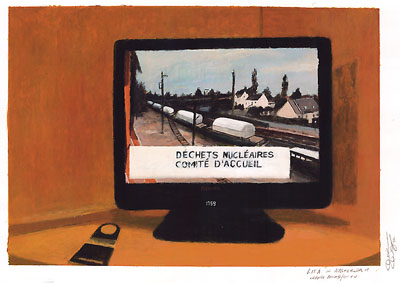 27-Fractures, acrylic on paper, November 2010, 70 x 50 cm 27-Fractures, acrylic on paper, November 2010, 70 x 50 cm
|
Why did you leave the television screen in some of your images?
I am working on a series in which I am photographing my screen. It consists of images of images. I think that it is very important to integrate the screen in the image. It’s also a way of exposing the process of the work. I am not going to deceive the spectator. I realized that the screen has its place. I appropriated this screen image and I reinstated it in the narrative. The screen images influence the project. So I need to reveal how these images influence me. It is as though I were a dike, and the waves had broken through the dike. At the same time, the act of piercing the dike will modify the landscape. That lets me be in constant osmosis with the project.
This series describes Hong Kong, but a Hong Kong in which you manage to eliminate the over flow of buildings as though these elements of the landscape were not necessary to the narrative itself.
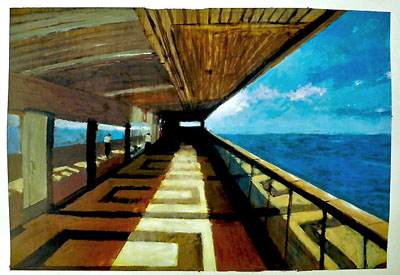 Fractures-Where to go, acrylic on paper, February 2011, 70 x 50 cm Fractures-Where to go, acrylic on paper, February 2011, 70 x 50 cm
|
This work takes a position in respect to photographic reality. I have made a filter, which synthesizes the essential forms in which I propose erasing the real. My subjectivity overtakes the real. My memory induces and engages a fictionalization.
It is possible now, because it is a process that began a long time ago. There are finally barriers that arise because there are things that become like evidence.
Finally, you have several types of images…
I have images that I have really experienced, lived--for example, my Corsican landscapes that I have made images of. It is a kind of memory-image. That is really a place that I experienced. Then there are the memory-images that come from the screen. Finally, there is the type of image where I combine an experienced landscape and a landscape that does not belong to my mental space. It is important for me to be in this maelstrom of questioning: What type of image? Why am I doing it? How am I doing it? Why integrate it, and how? That is why I have all these images on the wall because I live inside them. I sleep in this room and in the morning I awake with these images.
What is the most important time for you?
It is when there is this large white sheet before which I spend a moment, go outside time, of the measure and reach of the format, as a mental positioning, a first projection of the image that is going to be fixed.
Using acrylic demands applying layers. One moves from very chaotic shapes to an organization of these layers, which reveals the image.
Nothing is innocent. It is always this deep wave which is there and which carries everything with it.
You will continue to work in acrylic?
I don’t even ask myself about that. It is a technique, which I am completely integrated with, and with which I produce images. It is a way of neutralizing the technical aspect and of focusing myself on the revelation of the memory-image.
 12-Fractures, acrylic on paper, February 2011, 70 x 50 cm 12-Fractures, acrylic on paper, February 2011, 70 x 50 cm
|
You have several images of Hong Kong in which the architecture has disappeared to be replaced by the sea.
During the tsunami I was at a time when my personal life was also in upheaval. It was as though I were submerged and that translated itself in these images, which show the sea invading the city. It is also a fictional idea. The sea, which is a fiction, that invades the image. The city is underwater. I am going to the essential. I get rid of the overload of details of the buildings as well as the windows, and I only keep the form. Here is a small image of Hong Kong in which I began to flood the countryside. It is one of the axes of the project, which I will develop: that of cities that are flooded.
How did you decide on the generic title “Fracture” for your project?
I was in Corsica where I climbed to an altitude of around 2000 meters. I faced a glacier lake and there was an enormous wall of rocks, impressive, which plunged into the lake. I spent nearly two hours looking at the lines of fracture. I told myself, “Lines of fracture, fracture” and I thought of architecture. The architecture of the rock sent me back to the architecture of the city. It is this word “fracture” which underlies my project, because fractures or cracks induce ruptures, accident. The lines of fracture signify that there are layers, which accumulate to create something. Myself, from now on, I am also in that, in this accumulation of layers and of stratifications. |